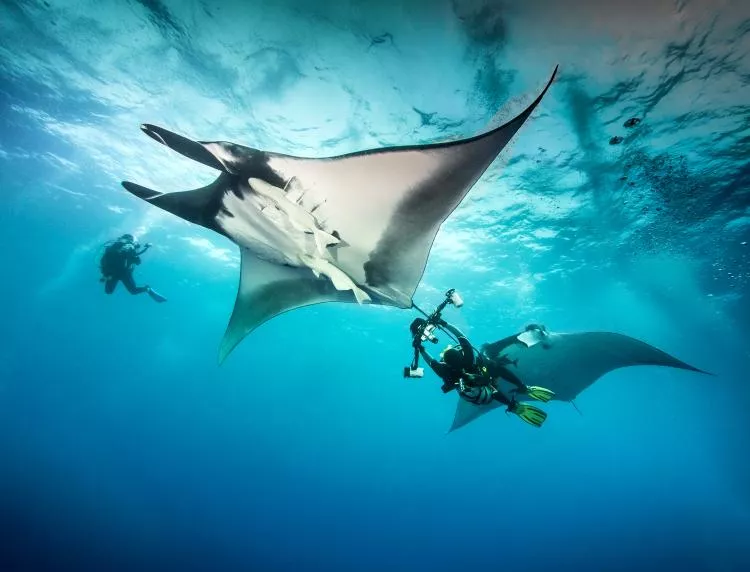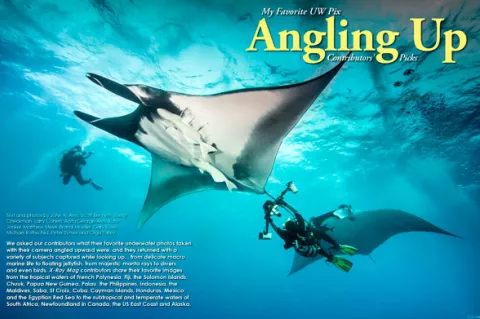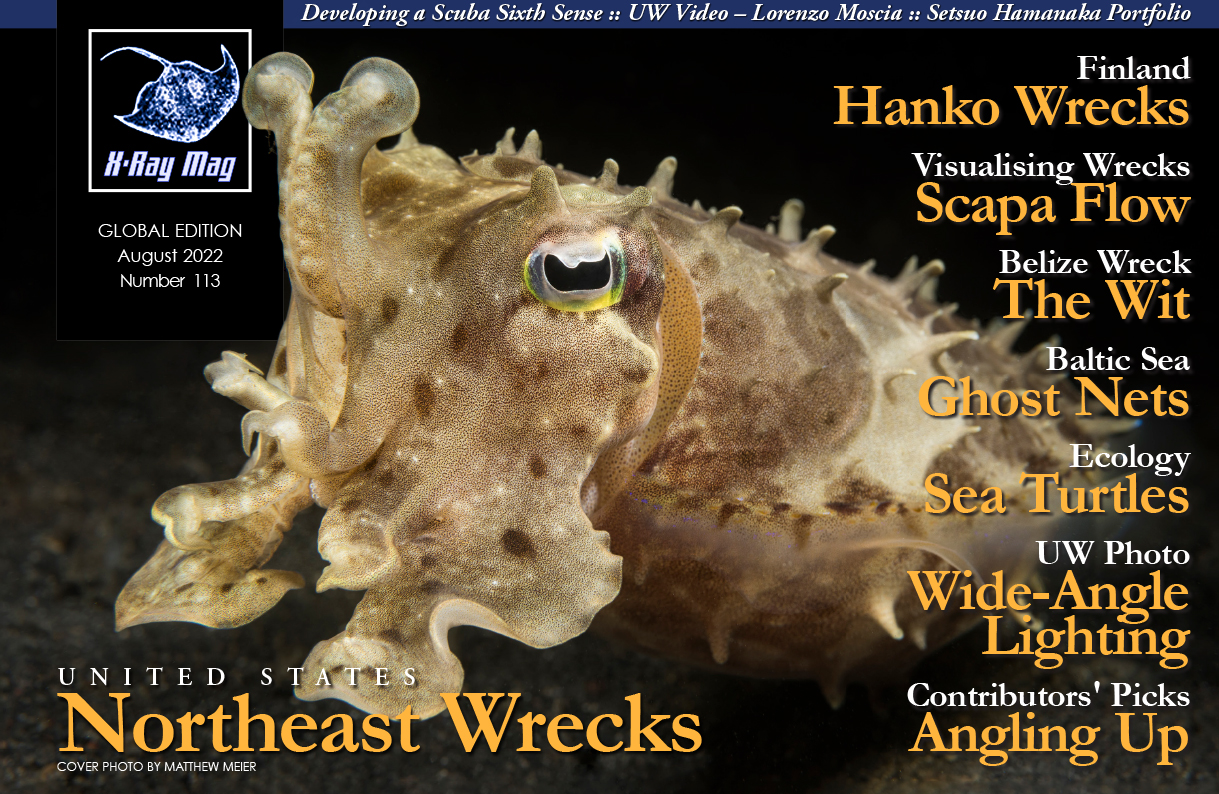We asked our contributors what their favorite underwater photos taken with their camera angled upward were, and they returned with a variety of subjects captured while looking up... from delicate macro marine life to floating jellyfish, from majestic manta rays to divers and even birds.
Contributed by
(To see all the images in the article, please scroll down and download the PDF)
X-Ray Mag contributors share their favorite images from the tropical waters of French Polynesia, Fiji, the Solomon Islands, Chuuk, Papua New Guinea, Palau, the Philippines, Indonesia, the Maldives, Saba, St Croix, Cuba, Cayman Islands, Honduras, Mexico, and the Egyptian Red Sea to the subtropical and temperate waters of South Africa, Newfoundland in Canada, the US East Coast and Alaska.
Depth, Strength and Power
Text and photos by Olga Torrey
One tip in photography is positioning the camera at an angle to achieve the desired composition. This is especially true when shooting underwater. Shooting at a low angle and looking up at the subject creates a sense of depth, strength and power.
I used this technique when capturing a diver wearing a Kirby Morgan 37 helmet as he emerged from the cold green waters of Dutch Springs in Pennsylvania, USA, into the sunny and warm weather at the surface. First, I followed the diver underwater, taking pictures at different angles by swimming over the subject, getting in front of or next to the diver. Then, I shot with a fisheye lens, using the water line across the frame to create this over-under photo. As the diver climbed up the stairs, I took the image at a low angle, emphasizing the gear.
I saw my first giant Pacific manta ray in Socorro, Mexico. The beauty and grace of this animal took my breath away. I could not take my eyes away from this large fish gliding effortlessly, looking like a cosmic creature from another planet. I angled my camera up under the manta passing over me to show its impressive wingspan and the pattern on the animal’s lower body. At this angle, I could also see two large remoras hitchhiking for a ride.
The Papoose was a tanker that sank off North Carolina, USA. It is an impressively large wreck and has many places to explore. The German submarine U-124 torpedoed the vessel during World War II. The tanker is now upside down on the ocean floor. I positioned my camera to show the wreck and the vast space of open water. My dive buddy, Larry Cohen, swam over the top edge, through the opening that faced my angled-up camera. The upward camera position and the diver shows the scale and how impressive the vessel is.
The cargo ship Aeolus was part of an artificial reef program in North Carolina. The vessel was broken into three sections, and some are resting at an upright angle, making this site an excellent multilevel dive. Sand tiger sharks are frequently seen here, so this is an exciting place to visit. On the dive, I pointed my camera up and waited for a shark to swim underneath the circular-shaped hatch. This space became the negative space around the shark’s torpedo-like body. This composition shows the texture of the wreck’s interior, with the ambient light coming through the ceiling, as well as the sand tiger shark’s magnificent power. Visit: fitimage.nyc
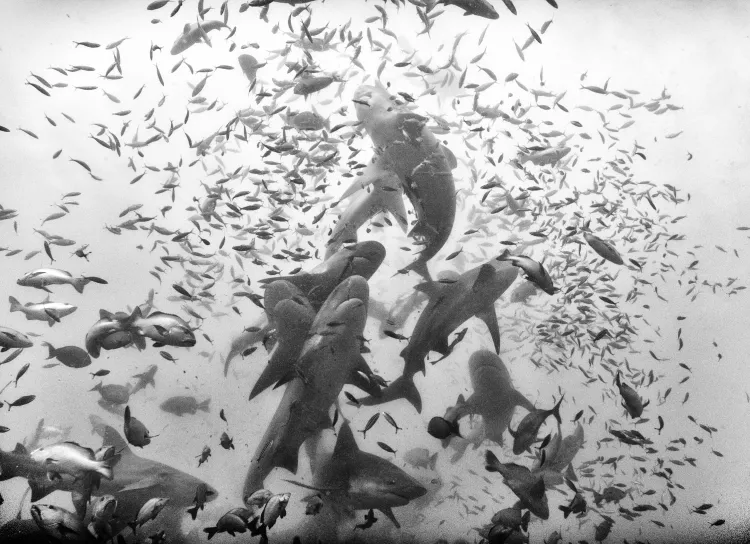
Overhead Views
Text and photos by John A. Ares
Many thousands of stingless jellyfish commute back and forth each day at the surface of Jellyfish Lake in Palau, as they follow the sun. Being translucent, the jellyfish benefit from being photographed from below. While freediving, I descended to about 10ft and shot upward through the jellyfish layer toward my dive buddy.
In a few places around the world, it is traditional to dump waste from fish processing back into the ocean. At Beqa Lagoon in Fiji, this has been occurring for over a hundred years, attracting many species of sharks. In a dive that can be best described as “controlled chaos,” I saw eight or nine bull sharks literally dumpster-diving into a patch of garbage containing fish parts. The action was compelling. Divers called wranglers swam behind the underwater photographers to push away any sharks that got too curious, using long poles called “shepherd’s crooks.”
Leru Cut is a unique, long and narrow cavern in the Solomon Islands. It is maybe 10ft wide. One enters the cavern near the bottom, at around 40ft or so, and exits at around 20ft, coming out on a spectacular wall. The blue glow of the surface was captivating when I was there, so placing a diver overhead was a natural choice.
It seems as if everything on the coral reefs in Papua New Guinea is red. In a tunnel at the Witu Islands, I found a sea fan that was typically red, adding a splash of color. Having the diver entering the frame while I was looking up through the hole in the reef made for a good composition. Visit: JohnAres.com
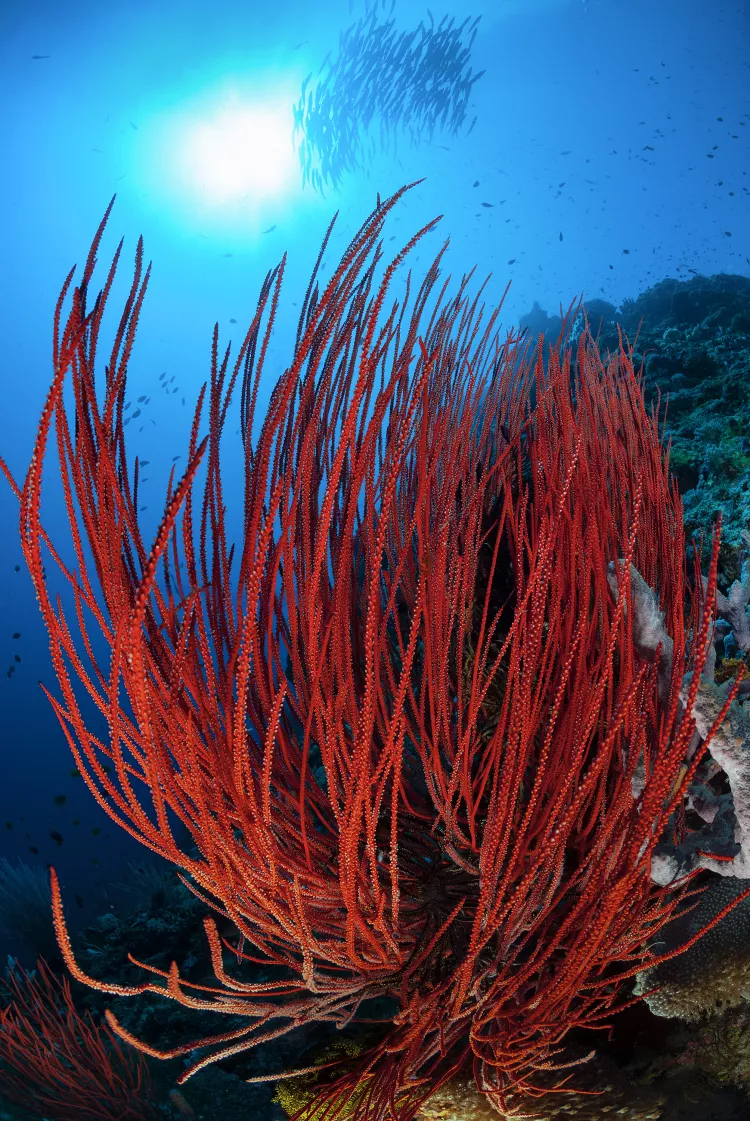
Waiting for the Right Moment
Text and photos by Scott Bennett
When it comes to wide-angle reef photography, Papua New Guinea’s Kimbe Bay has few equals. In the Witu Islands, I encountered several hawksbill sea turtles grazing on a seamount. Suddenly, one headed to the surface for a gulp of air. On its descent, I positioned myself directly beneath, until the turtle was less than a metre from my dome port. Two strobes illuminated its belly, with my fisheye lens capturing both the turtle and the sunburst above it.
At another site in the Fathers Reefs, some whip corals proved especially photogenic, their vivid red contrasting sharply with the clear, blue water. With the sun clearly visible, I manoeuvred until it was positioned directly above the whip coral. Aiming upwards, I waited until a school of chevron barracuda moved into the frame. Exposure was set using ambient light, while two strobes set at half power illuminated the coral without overexposing it.
Mexico’s remote Socorro Islands are a mecca for big-animal encounters, with giant mantas the star attractions; during a recent liveaboard trip, I encountered multiple individuals on virtually every dive. At Cabo Pearce, I was positioned near a drop-off when one materialised out of the blue, swimming directly towards me. At the last minute, it veered off, banking like the world’s most graceful fighter jet. Two strobes set at half power brightened its belly.
Having done the majority of my dives in tropical reefs, visiting Cape Town in South Africa and its temperate seas proved a revelation, with its kelp forests illuminating a wealth of photo possibilities. During the summer, photography proved challenging, with limited visibility hampering attempts to capture the kelp’s full extent. At the end of one dive, I looked up to see clear water, with the kelp fully visible, ascending to the surface. As I framed the image, some passing fish completed the composition. Please visit: xray-mag.com/Contributors/Scott-Bennett
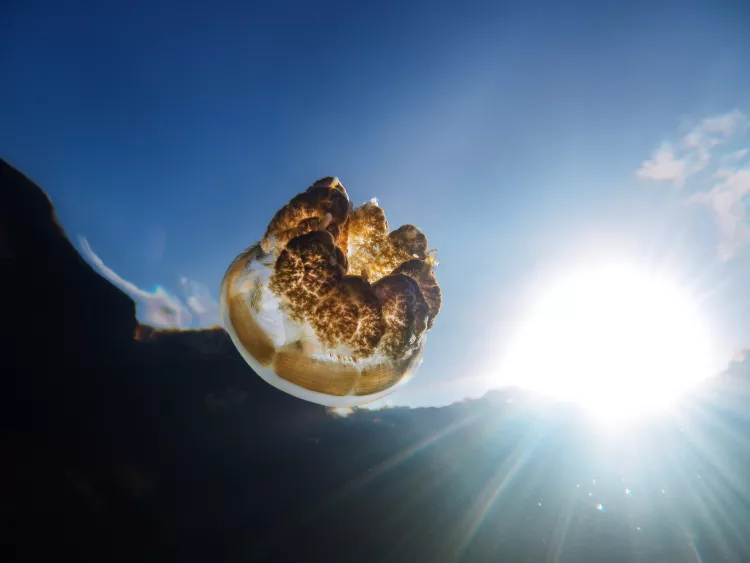
The Dramatic Direction
Text and photos by Sheryl Checkman
It is really easy when diving to focus on what is right in front of me. If I am diving on a wall, I will look for creatures inhabiting the nooks and crannies, and then occasionally look out into the blue to see what might show up. Diving on a reef, I will look left, right and in front of me. However, I am leaving out one very important direction—up. When I adjust my gaze upward, I am often rewarded with a more dramatic photo.
When I went on a shark dive at Cara-a-Cara (Marco’s Place) in Roatan, I knew the sharks would be swimming above us, so I concentrated on focusing my camera up, as the sharks swam overhead. I was able to capture the shot of a reef shark, swimming with a fishing line and hook dangling from its mouth, and its white underside illuminated by my strobe.
Diving at Tent Wall off the Caribbean island of Saba, I saw a sea turtle swimming towards me. I waited until it swam right over me and was able to capture a unique perspective of the turtle with a Snell’s window (an effect caused by the refraction of light entering the water) and a diver behind it.
In Little Cayman, at Marilyn’s Cut, I captured an image of a sea turtle swimming up toward the light, against the vertical beams of light filtering down from the surface.
In Palau, I snorkeled at Jellyfish Lake and could not resist photographing a jellyfish, while looking straight up. The water was so clear that the jellyfish looked as if it was floating in the sky! Visit: instagram.com/sherylcheckman
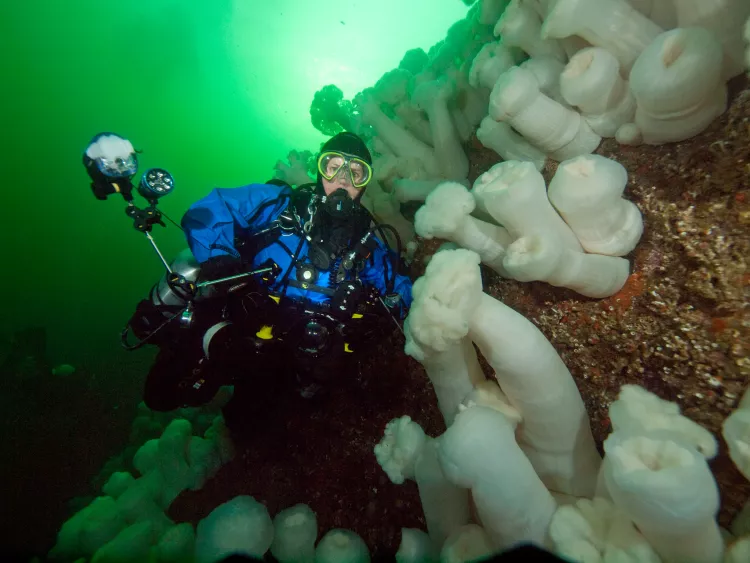
Larger Than Life
Text and photos by Larry Cohen
One of the rules of underwater photography is to shoot upward. Of course, rules are made to be broken, but taking a photo from a low angle does make subjects look majestic and larger than life. Also, when taking pictures underwater, it is easier to use the water as the background when shooting at an upward angle.
When diving in the Gardens of the Queen in Cuba, I saw a conch shell on a wall that looked interesting. So, I got under the shell to get the lush marine growth and blue water in the background. Luckily, as I framed the image, a goliath grouper entered the frame at the same angle as the wall. Sometimes, the perfect composition is a matter of luck!
While diving in Alaska, my dive buddy, Olga Torrey, and I were on a wall decorated with giant metridium anemones. I got low on the wall to make these spectacular anemones more majestic. Olga got close to the wall for scale, so the viewer could see how giant these anemones were compared to a diver. I also exposed the ambient light to get an emerald green background.
Diving off the Bay of Pigs area in Cuba, we explored some heavily decorated walls. In this image, I get underneath a yellow sponge. I also asked our dive guide to hover next to the wall and look at the sponge. Visit: liquidimagesuw.com
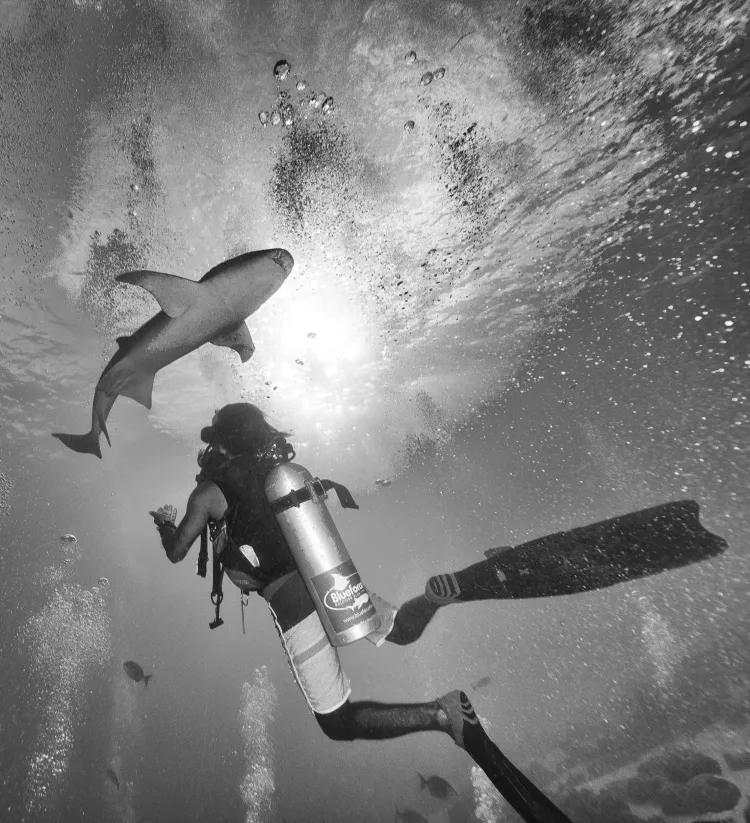
Beyond Surreal
Text and photos by Anita George-Ares
Alimatha Island in the Maldives has a large population of tawny nurse sharks. I converted the image of a diver ascending towards a nurse shark into black and white, as I liked the increased contrast.
At Bahura South dive site off the Dauin coast in the Philippines, the dive guide saw a small school of squid near the surface and drew my attention to it. I cropped the image significantly and converted it to black and white to improve the contrast. The wide ripples on the water’s surface remind me of clouds. Squid flying below the clouds would be a subject worthy of the surrealist artist Magritte.
During my first dive at Sumilon Island in the Philippines, I took a photo of the reef, shooting up towards the sun. I chose the image of the school of fusiliers as I liked the feeling of movement created by the fish flowing over the coral head. During the second dive, it suddenly got very dark underwater. I looked up and saw that it was raining hard at the surface. The falling rain created an interesting, pebbled texture on the water’s surface.
I like the diagonal composition in the image of the humpback whale mother and her calf, ascending to the surface. Converting the image to black and white improved the appearance of the penetrating light rays. Please visit: facebook.com/profile.php?id=100016947967639
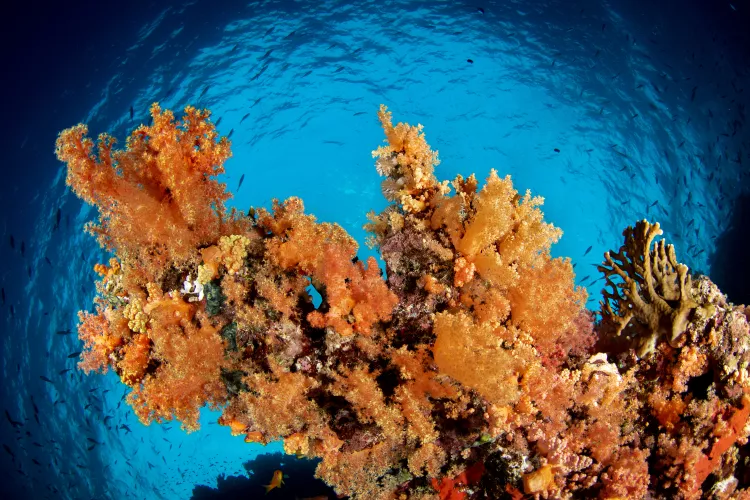
Look Up for Luck
Text and photos by Kate Jonker
How often do you look upwards when you are diving? Probably not as often as you should! Imagine how many of the larger marine animals you have missed!
I, for one, am guilty of not looking up enough. I have had sharks, whales and rays swim right over me, and only known about it when, after the dive, my dive buddies asked me if I saw the ray that almost hit me on the head, or the zebra shark that I had always want to see whilst I was photographing the Bornella anguilla nudibranch, which I had also always wanted to see.
As an underwater photographer, looking up and shooting upwards can result in beautiful photos. For macro photography, angling your camera upwards at a subject positioned on top of a coral or rock can create beautiful black backgrounds, as there is nothing to reflect your strobe’s light back at you.
Looking upward really comes into its own with wide-angle underwater photography. You can capture the beautiful circle of Snell’s window, create silhouettes of marine animals or divers when shooting into the sun, photograph corals and reefs with the texture of the ocean in the background and add beautiful gradients to your water column when shooting at depth towards the sun.
By having a “look-up” mindset whilst diving, especially when taking wide-angle images, you are more likely to capture (and not miss!) the whale shark, dolphin, ray or shark passing overhead, and come back with images that have added depth and a uniqueness to them. Visit: katejonker.com
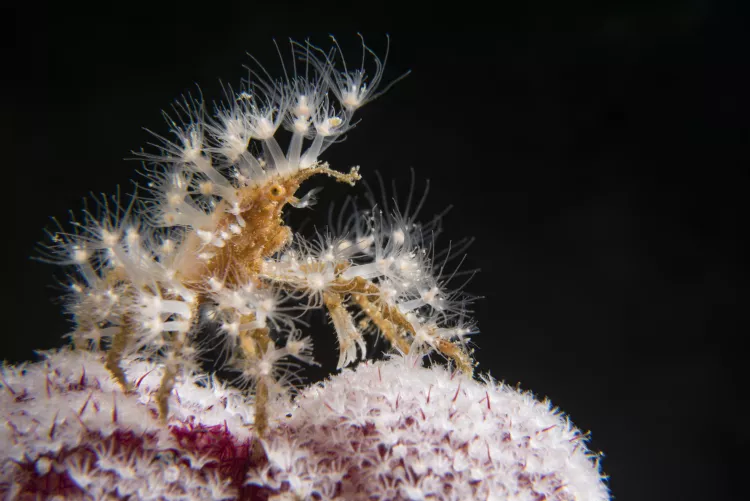
Elevating the Subject
Text and photos by Matthew Meier
As an underwater photographer, there are a few universal lessons that are engrained from the beginning. One is to get close and then get closer, and the other is to get low and shoot up. Pointing the camera up situates the subject in an elevated position and allows the audience to perceive it as being distinguished. Similar to a lecturer or religious leader speaking from a stage or pulpit, we look up to them as an authoritative figure.
When photographing animals, especially those living near the ocean floor or amongst a busy background, shooting up also helps to eliminate distracting elements behind the subject. In the case of the examples shown here, I also employed the use of snoots over my strobes to restrict the light from going beyond my subject, and by using a fast shutter speed, low ISO and a large aperture, I was able to create a black background to further isolate and highlight each critter. Visit: MatthewMeierPhoto.com
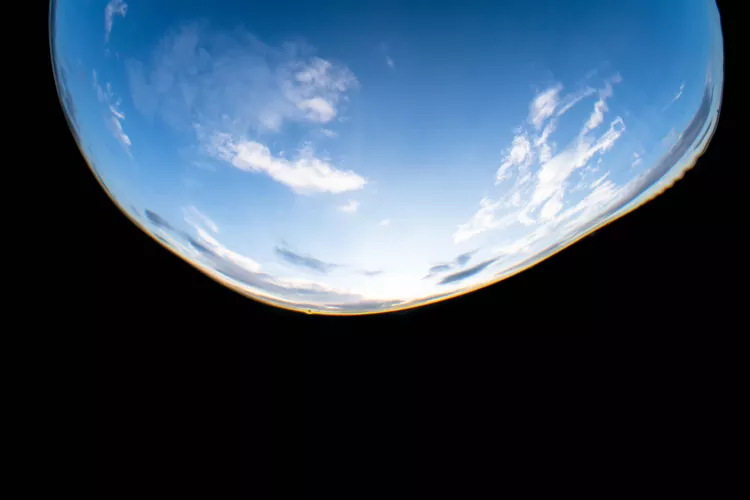
A Different Perspective
Text and photos by Brandi Mueller
Getting below and shooting up at your subject is one of the most popular rules of underwater photography, and for good reason. I love “angling up” to capture a different perspective than what we usually see when looking down on the reef. I also really like seeing the undersides of things we often are not used to viewing from below.
The effect of Snell’s window often creates the most interesting shots, when looking to the surface, as if one is observing the topside world through a drop of water or a bubble. When sunbeams shine down into the water, the rays of light can be fun to try to capture—even more so, if they are shining on pink lily pads, which appear to grow like trees in an enchanted forest, with real trees visible beyond the water. And it is not every day that you look up to see a swimming bird peering down at you. Visit: brandiunderwater.com
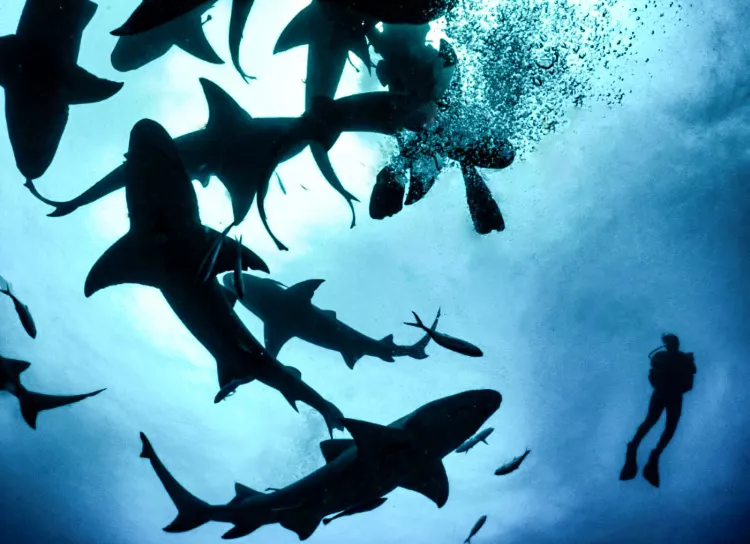
When Things Are Looking Up
Text and photos by Gary Rose, MD
As divers, we are almost always looking forward and slightly down, or more comfortably just looking down. We are taught to be as close to the prone position as possible to improve buoyancy control, to decrease drag, and to see where we are going. Even our equipment increases our tendency to look down—the buoyancy compensator, holding the tank on our back with the top of the first stage of the regulator sitting high enough to prevent full neck extension. I know, some of you will say, “set up your tank lower,” to improve neck extension. My response is, “In that case, you will have a tank bottom hitting the back of your thighs with each kick.”
Having made my point, I encourage you to make a practice of looking up during your dives. There is so much that goes on, above, that you are missing. Either learn to be more proficient in extending your neck or assume a vertical position (without disturbing the reef or sea floor) and look up. I have seen sailfish glide by on the surface. I have witnessed schools of scalloped hammerhead sharks above me in the Gulf Stream. I could not believe it, but last year, I saw a 5ft Mola mola (sunfish) hanging 20ft above my head.
I would not have seen the beautiful and very pregnant tiger shark in Photo 1, had I not looked up. I also would not have seen the reef sharks and beautiful lighting. I was in 60ft of water when I photographed the gorgeous silky shark in Photo 2, soaring right over me. Shooting up with a wide-angle lens captured the moment perfectly. Unfortunately, we sometimes witness the harm that others impose upon magnificent apex predators—in this case, stainless steel hooks impaling a silky shark in Photo 3.
By not using strobes, while shooting up, you can capture beautiful silhouettes, which are very effective in evoking strong emotions in the viewer. Feel the passion of the lone diver in Photo 4, gazing at a “sharknado” of lemon sharks.
Explore your surroundings. Appreciate the natural beauty. Remember to look up. Visit: garyrosephotos.com
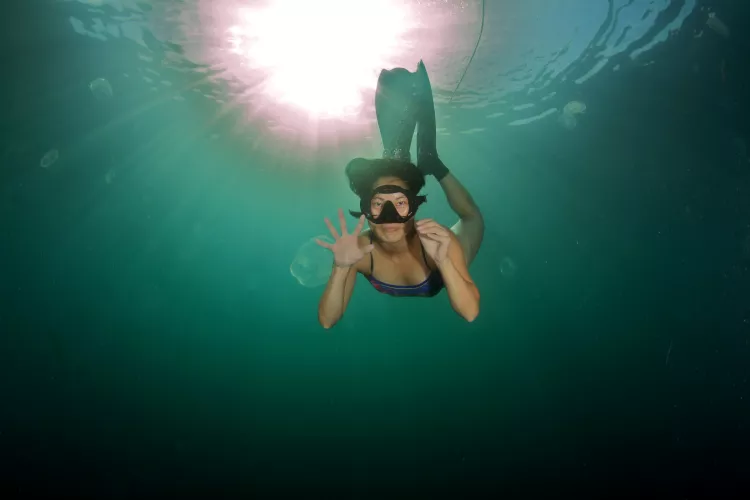
The Surface Beckons
Text and photos by Michael Rothschild, MD
As much as divers love being underwater, we are air-breathing mammals. No matter how skilled, trained and technically equipped we may be, sooner or later, the surface beckons. It is at the back of our minds as we start our dive, but as time goes on, as tank pressure drops and as nitrogen accumulates, the drive to pierce that shining ceiling becomes stronger and stronger, until it can be resisted no more. So, it seems natural that the surface is the subject of many of my favorite photographs. All of these images—like most shot at this angle—incorporate Snell’s window to frame the subject.
The first image (Photo 1) is of my dive buddy on a surface interval. I love her expression and her hand gesture. I also like the balance of the strobe on her face against the sunball, with a few moon jellies to break up the green backdrop.
The second image (Photo 2) is of a divemaster at the end of a safety stop. Both his smile and his body language suggest the joy of diving. And like the first image, it is driven by a diver’s face with no regulator to hide that grin.
The third image (Photo 3) is of a tank of oxygen suspended from a dive boat at Chuuk (Truk) Lagoon in Micronesia. The lines in this photo are strong elements, radiating outwards from the sunball along with the rays of light, including the equipment lines, ladder and anchor line. You can imagine what a welcome sight this is to a diver running low on deco gas.
The fourth image (Photo 4) is of “the prettiest junkyard in the world”—the harbor of the town of Dildo, in Newfoundland, Canada. The waters here are stunningly clear, letting one to easily see the thousands of bottles and other debris that cover the floor of this cove. Visit: dive.rothschilddesign.com
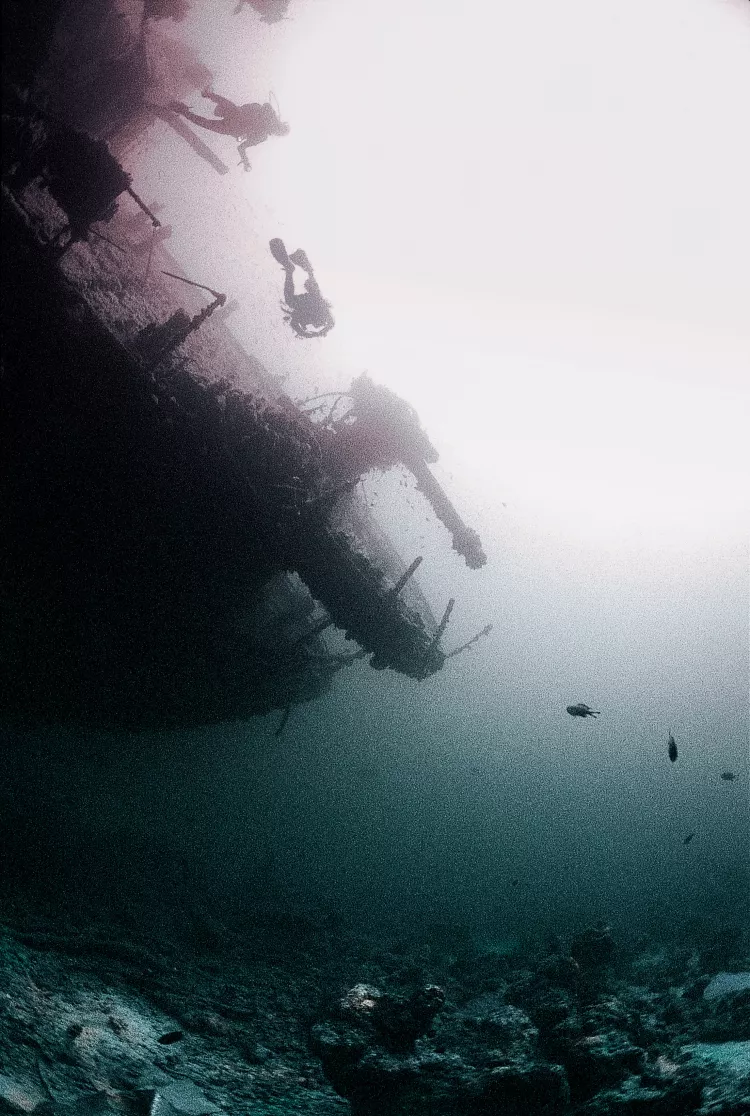
Opposites
Text and photos by Peter Symes
These two images are opposites. One is black and white, and the other is in colour; one depicts a wreck versus marine life; and one is vertical versus horizontal. One is shot on film and the other is digital. But perhaps more significantly one is largely planned beforehand, while the other was a chance occurrence.
The image of the wreck, which some may recognise as the Thistlegorm in the Red Sea, I envisaged beforehand. I descended some minutes ahead of the main group of divers and got as low as I could on the seabed, behind the twisted-off stern with the iconic cannon. I laid on my side and rested the side of the camera on the sand, angling its upwards while trying to frame the image. As the divers came down, I shot off a series, in quick succession. This was shot on film and scanned, so the dynamic range is not up to what present-day digital cameras are capable of, but the graininess gives it some sort of old-school press-photo quality.
The tiger shark, on the other hand, pretty much framed itself, as I was underneath it. That a big predator takes up guard right between you and safety, and where you want to go, can be a tad intimidating, but I think I was mostly in awe of it. On a semi-silly thought: Does being pinned to the seabed by a shark constitute an overhead environment?

